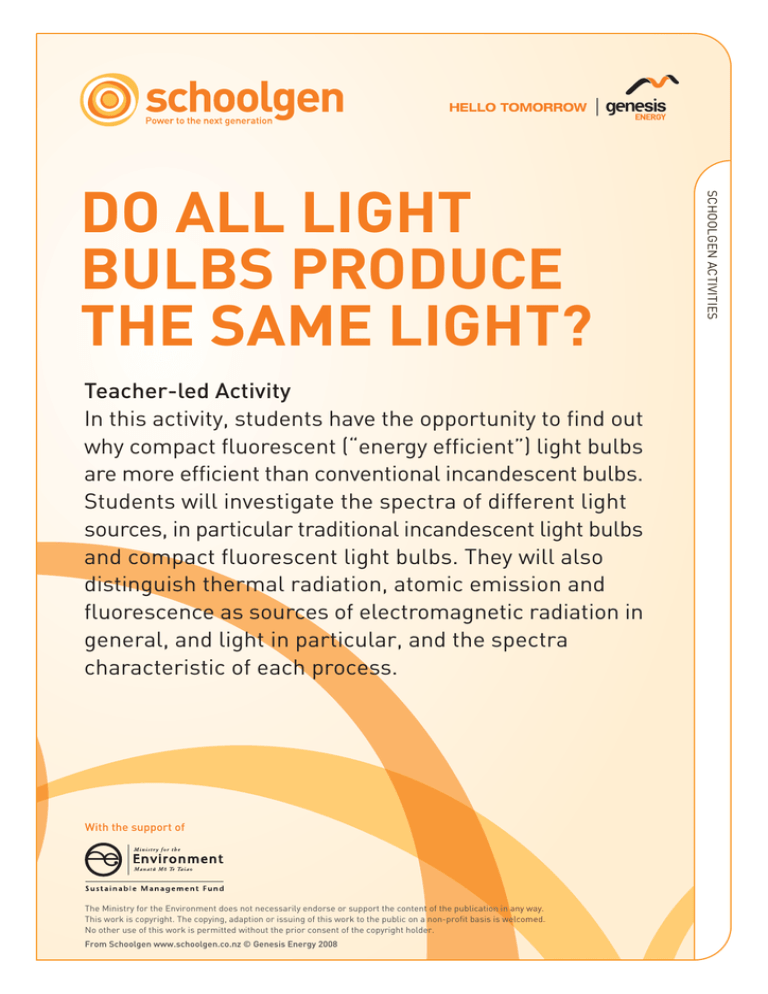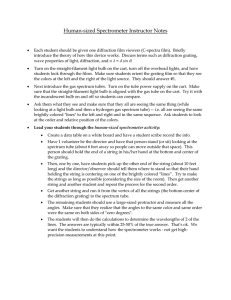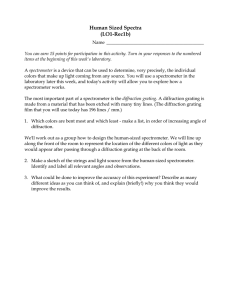Do all light bulbs produce the same light (Teacher led activity)
advertisement

Teacher-led Activity In this activity, students have the opportunity to find out why compact fluorescent (energy efficient) light bulbs are more efficient than conventional incandescent bulbs. Students will investigate the spectra of different light sources, in particular traditional incandescent light bulbs and compact fluorescent light bulbs. They will also distinguish thermal radiation, atomic emission and fluorescence as sources of electromagnetic radiation in general, and light in particular, and the spectra characteristic of each process. With the support of The Ministry for the Environment does not necessarily endorse or support the content of the publication in any way. This work is copyright. The copying, adaption or issuing of this work to the public on a non-profit basis is welcomed. No other use of this work is permitted without the prior consent of the copyright holder. From Schoolgen www.schoolgen.co.nz © Genesis Energy 2008 SCHOOLGEN ACTIVITIES DO ALL LIGHT BULBS PRODUCE THE SAME LIGHT? DO ALL LIGHT BULBS PRODUCE THE SAME LIGHT? 1. INTENDED LEARNING OUTCOMES The students will be able to: Use physics ideas about light to explain how different types of light bulb function Design and carry out experiments using commonly available laboratory equipment and/or precision instruments, in particular a spectrometer and the vernier scale Collect and analyse experimental data and consider the main source(s) of experimental uncertainty and estimate their effect(s) on the precision of the result when they investigate the spectra emitted by different light bulbs Gain an understanding of the processes of thermal radiation, atomic emission and fluorescence as sources of light. 2. WHAT YOU NEED An incandescent light bulb A compact fluorescent (energy efficient) light bulb A sodium or mercury discharge lamp (if available) A lamp holder/light box (safely wired!) A 60 glass prism Diffraction gratings and/or diffraction spectacles (see 8. RESOURCES below) A spectrometer (if available) A 10-metre tape measure Black cloth to block out room light (optional) Copies of the student fact sheets The Vernier Scale and Lamps, Light and Spectra for students to read. 2 3. FOCUS Ask the students questions like: What is light? Light bulbs convert electrical energy to light. What physical processes are involved in the production of light: - In a spectral lamp? - In a compact fluorescent (energy efficient) light bulb - In an incandescent light bulb? Are all light bulbs equal? - Do all bulbs produce the same quality (sort) of light? - Do all light bulbs produce the same amount of light for the same energy input? Why are some bulbs more efficient than others? Why does the white light emitted by one type of bulb look different from that emitted by another type of bulb? 4. MANAGING THE ACTIVITY Part 1: Spectrometer Activities Familiarisation A spectrometer (see Figure 1) is a precision instrument for measuring the angles through which light is deviated as it passes through various optical components, e.g. by refraction, reflection or diffraction. If you do not have a spectrometer, you can still complete the activities in Part 2. Ask the students to: (i) Identify the parts of the spectrometer, particularly DO ALL LIGHT BULBS PRODUCE THE SAME LIGHT? The fixed collimator with adjustable slit The platform with angular scale, which can be clamped in position, or free to rotate The telescope with crosswires, focussing lens and eyepiece. Do not try to adjust the levelling screws under the main platform. 3 Diffraction Ask the students to: (i) Fix the grating holder onto the spectrometer platform and insert the diffraction grating. (ii) Check that the diffraction grating is perpendicular to the line of the collimator and telescope and clamp the platform: Light source Light source Collimator Telescope Figure 1: The spectrometer (ii) Become familiar with the spectrometer by having them: Place the incandescent light source at the collimator slit, and turn it on Align the telescope with the collimator and find the image of the slit Focus the telescope and adjust the slit until they have a fine, sharp image Clamp the platform, check that the slit image is exactly on the crosswire. Read the vernier scale (see the student fact sheet The Vernier Scale) and record the reading. This is the straightthrough position of the telescope. Collimator Diffraction grating First order diffraction Viewer q1 Telescope straight-line through position Figure 2. A birds-eye view of the spectrometer set-up, with the diffraction grating mounted on the platform, and the telescope rotated by an angle q1 from the straight-through position to the first order diffraction line. DO ALL LIGHT BULBS PRODUCE THE SAME LIGHT? Sodium Discharge Bulb Ask the students to: (i) Switch on the sodium lamp and place it at the collimator slit. (Note this lamp may take several minutes to warm up to its full brightness.) Find the straightthrough beam in the telescope, and check that reading on the vernier scale is the same as previously. (ii) Rotate the telescope slowly to the left until you see the first order diffraction line (see Figure 2). (iii) Record the reading on the vernier scale: the difference between this reading and the straight-through reading is q1. (iv) Repeat the same procedure, rotating the telescope to the right of the straight through position, to find the other first order diffraction line, and make another measurement of q1. If the grating is aligned accurately the first order diffraction lines will be symmetrical at about the straight-through position. (v) Take the average value of q1 and calculate the wavelength l (see the student fact sheet Lamps, Light and Spectra). On rotating the telescope further to the right or left, students may be able to locate the (much fainter) second order diffraction lines the angles to these lines can also be measured and used to calculate further estimates of the wavelength. 4 Mercury Discharge Bulb Ask the students to: (i) Replace the sodium source with the mercury bulb and look at the diffracted spectrum. Unlike sodium, which emits one wavelength in the visible spectrum: an orange colour, mercury emits several. Normally we see them all mixed together, and the combined effect is white light, but when separated by the diffraction grating, we see them as different colours. (ii) Ask the students to describe the colours and to measure the angles of the fist order lines from the straight through position and so calculate their wavelengths. (iii) Calculate the frequencies of these lines, and the energies of the corresponding photons. (iv) Consider what these energies relate to in terms of the atoms of mercury vapour in the lamp bulbs. Both mercury and sodium lamps are used in street lighting. Ask the students to answer questions like: Can you figure out why these types of lamps are also called spectral lamps? How would you expect red, green and blue objects to appear under each of these lights? Check the students responses by holding different coloured objects under the different light sources, blocking out the room light with the black cloth. Suggest the students test their answers next time they are out at night. DO ALL LIGHT BULBS PRODUCE THE SAME LIGHT? Compact Fluorescent Bulb Ask the students to look at the spectrum from the compact fluorescent bulb and describe what they see, in particular in comparison with the mercury discharge bulb. As well as discrete lines (wavelengths), what additional component is there in this spectrum? What is the origin of this additional component? What effect do you think it has? Incandescent Bulb Ask the students to: (i) Examine the spectrum from the incandescent (ordinary) light bulb. (ii) Estimate values of q1, for the red and violet ends of the spectrum and use these values to estimate the range of wavelengths visible to the human eye. (iii) Check whether their calculated values agree with those given in the student fact sheet Light, Lamps and Spectra. (iv) Compare this with the others viewed so far. Conclusions Ask the students to answer questions such as: How would you compare the spectra of the incandescent and compact fluorescent bulbs? Which spectrum is more like the solar spectrum? Which (if any) colours would you expect to appear different under the two lights and why? 5 Which bulb would you expect to produce more infrared radiation (heat)? Which bulb would get hotter during running? Which would you expect to be more energy efficient? Why? Part 2: Diffraction Spectacles Activities If your school does not have a spectrometer, students can see all the same effects, and even make satisfactory, but less precise, measurements by holding a diffraction grating up to the eye, or using the diffraction spectacles (see 8. RESOURCES) in a room with dimmed lighting. Ask the students to: (i) Place a light source up against a plain, preferably white wall. (ii) Stand some 5-10 metres away and look at the light through a diffraction grating (with the rulings vertical), or wearing the diffraction spectacles. DO ALL LIGHT BULBS PRODUCE THE SAME LIGHT? 6 Figure 3: The first order diffraction spectrum (to left and right) produced by viewing a mercury discharge lamp (centre) through diffraction spectacles. Note that most of the light from the lamp passes straight through the grating into the students eyes, so they see the lamp in its correct position. However light is also diffracted so that maxima occur at angles of q1, q2 etc., either side of the straight-through direction, as shown in Figures 3 and 4. This light enters the students eyes, and they interpret it as if it has come straight through the grating. In other words, they see virtual images of the lamp at angles q1, q2 either side of the actual lamp, and the images seem to be located on the wall. Since q1 and q2 depend on wavelength (colour), multiple coloured images are seen one for each wavelength of the spectrum. white or lightcoloured wall diffraction grating, spacing d virtual image x1 Viewer d1 q1 d1 light source, wavelength l L Figure 4: Viewing the diffraction pattern of a light source through a diffraction grating or grating spectacles. The experiment should be done in a darkened room, the distance L should be 510 metres, and the pattern should be viewed against a flat light coloured wall. DO ALL LIGHT BULBS PRODUCE THE SAME LIGHT? Ask the students to note from the diagram that once they have measured L, their distance from the wall, and x1, the distance of the first order virtual image from the lamp, they can calculate q1: tan q1 = x1 L Using the same equation for the angle to the first order maximum as previously, the students can then calculate the wavelength, l , of the light: d sin q1 = l where d is the spacing of the rulings or lines of the diffraction grating = 1/(number of lines per metre). Students will need to work in pairs to measure x1, since only one person can see the virtual image, and only when he/she is standing a distance L from the wall and looking through the diffraction grating/spectacles! Ask the students to think about how they will do this, and how precise their measurements of L and x1 need to be. As with the spectrometer, start off with the sodium spectral lamp, then the mercury lamp, and finally the compact fluorescent and incandescent light bulbs. In each case make measurements and answer questions as for the spectrometer experiments. 7 5. REFLECTION Ask the students questions such as: Which of all the light sources used in this experiment is most energy efficient? Which light source produces the most natural-looking white light? What other factors should be considered when designing an environmentally friendly lamp? 6. EXTENSION Sir Isaac Newton described the spectrum of colours in white light in his famous book Optiks, which was published in 1704. He had split ordinary white sunlight into its spectrum by passing the narrow beam of light that came between the slats of his window-blinds through a glass prism, and onto a screen (Figure 5). Students can produce a spectrum in the same way using a glass prism and the spectrometer. Figure 5: Sir Isaac Newtons experiment to display the spectrum of sunlight. DO ALL LIGHT BULBS PRODUCE THE SAME LIGHT? Ask the students to: (i) Use the incandescent light bulb. (ii) Place the prism at the middle of the platform, so that the light from the collimator strikes the middle of one face at approximately the angle shown in Figure 6. (iii) Rotate the telescope clockwise until they find the refracted light. (iv) Describe the spectrum they see and compare it with the spectrum seen through the diffraction grating. Figure 6: A spectrometer from above, with glass prism to view a refracted spectrum. 7 7. SAFETY GUIDE Ensure all lamps are safely wired. If using a spectrometer, a technician or teacher should level it initially. Students should be warned not to adjust the levelling thereafter. Handle prisms and diffraction gratings with respect. To avoid damage, touch only the edges. Do not look directly at naked light bulbs. 8. RESOURCES Diffraction Grating Glasses are available at around US45c each for orders over 50 at Rainbow Symphony website: http://www.rainbowsymphony.com. ACKNOWLEDGEMENTS This experiment is a modification of one developed for use at Victoria University of Wellington by Gillian Turner. The diffraction spectacles experiments evolved from an idea suggested by Rory OKeefe and John Hannah.

